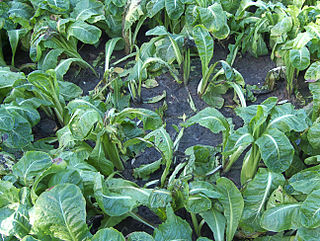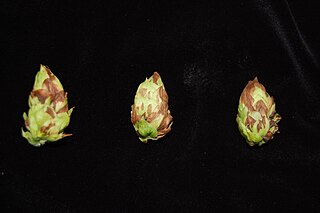 W
WAster yellows is a chronic, systemic plant disease caused by several bacterium-like organisms called phytoplasma. The aster yellows phytoplasma (AYP) affects 300 species in 38 families of broad-leaf herbaceous plants, primarily in the aster family, as well as important cereal crops such as wheat and barley. Symptoms are variable and can include phyllody, virescence, chlorosis, stunting, and sterility of flowers. The aster leafhopper vector, Macrosteles quadrilineatus, moves the aster yellows phytoplasma from plant to plant. Its economic burden is primarily felt in the carrot crop industry, as well as the nursery industry. No cure is known for plants infected with aster yellows. Infected plants should be removed immediately to limit the continued spread of the phytoplasma to other susceptible plants. However, in agricultural settings such as carrot fields, some application of chemical insecticides has proven to minimize the rate of infection by killing the vector.
 W
WBacterial leaf scorch is a disease state affecting many crops, caused mainly by the xylem-plugging bacterium Xylella fastidiosa. It can be mistaken for ordinary leaf scorch caused by cultural practices such as over-fertilization.
 W
WDidymella bryoniae, syn. Mycosphaerella melonis, is an ascomycete fungal plant pathogen that causes Gummy stem blight on the family Cucurbitaceae [1-3]. The anamorph/asexual stage for this fungus is called Phoma cucurbitacearum [2]. This pathogen commonly affects the foliage and stems of plants from the family Cucurbitaceae, which includes cantaloupe, cucumber, muskmelon and watermelon plants [1,3,8]. When this pathogen infects the fruit of cucurbits it is called black rot [2].
 W
WErysiphe betae is a plant pathogen. It is a form of powdery mildew that can affect crops of sugar beet, when it can cause up to a 30% yield loss. The fungus occurs worldwide in all regions where sugar beet is grown and it also infects other edible crops, e.g. beetroot.
 W
WFusarium oxysporum f.sp. albedinis is a fungal plant pathogen that causes a disease known as Bayoud disease or fusarium wilt primarily on date palm.
 W
WHalo blight of bean is a bacterial disease caused by Pseudomonas syringae pv. phaseolicola. Halo blight’s pathogen is a gram-negative, aerobic, polar-flagellated and non-spore forming bacteria. This bacterial disease was first discovered in the early 1920s, and rapidly became the major disease of beans throughout the world. The disease favors the places where temperatures are moderate and plentiful inoculum is available.
 W
WHeterodera schachtii, the beet cyst eelworm or sugarbeet nematode, is a plant pathogenic nematode. It infects more than 200 different plants including economically important crops such as sugar beets, cabbage, broccoli, and radish. H. schachtii is found worldwide. Affected plants are marked by stunted growth, wilting, yellowing, decreased yields, and death. While there are many methods of control, crop rotation with non-susceptible plants is preferred.
 W
WPeronospora farinosa f.sp. betae is a forma specialis of Peronospora farinosa, attacking sugar beet.
 W
WPleospora betae is a plant pathogen infecting beet. It contains the chemical substances betaenone A, B and C. Pleospora betae develops on dead beet residues and is a marsupial stage of the Phoma betae anamorph, parasitizing on beets and causing a number of harmful diseases.
 W
WPodosphaera macularis is a plant pathogen infecting several hosts including chamomile, caneberrie, strawberries, hop, hemp and Cineraria. It causes powdery mildew of hops.
 W
WPseudomonas marginalis is a soil bacterium that can cause soft rots of plant tissues. It infects poinsettia, lettuce, and crucifers.
 W
WPseudoperonospora humuli is a plant pathogen that causes downy mildew on hops.
 W
WPythium debaryanum is a species of water mould in the family Pythiaceae. It is known as a plant pathogen on many kinds of wild and cultivated plants, including peanut, beet, eucalyptus, tobacco, and pine trees. The plants develop damping off, a disease state.
 W
WRosellinia necatrix is a fungal plant pathogen infecting several hosts including apples, apricots, avocados, cassava, strawberries, pears, hop. citruses and Narcissus, causing white root rot.
 W
WTheliaviopsis basicola is the plant-pathogen fungi responsible for black root rot disease. This particular disease has a large host range, affecting woody ornamentals, herbaceous ornamentals, agronomic crops, and even vegetable crops. Examples of susceptible hosts include petunia, pansy, poinsettia, tobacco, cotton, carrot, lettuce, tomato, and others. Symptoms of this disease resemble nutrient deficiency but are truly a result of the decaying root systems of plants. Common symptoms include chlorotic lower foliage, yellowing of plant, stunting or wilting, and black lesions along the roots. The lesions along the roots may appear red at first, getting darker and turning black as the disease progresses. Black root lesions that begin in the middle of a root can also spread further along the roots in either direction. Due to the nature of the pathogen, the disease can easily be identified by the black lesions along the roots, especially when compared to healthy roots. The black lesions that appear along the roots are a result of the formation of chlamydospores, resting spores of the fungi that contribute to its pathogenicity. The chlamydospores are a dark brown-black color and cause the "discoloration" of the roots when they are produced in large amounts.
 W
WTrichothecium roseum is a fungus in the division Ascomycota first reported in 1809. It is characterized by its flat and granular colonies which are initially white and develop to be light pink in color. This fungus reproduces asexually through the formation of conidia with no known sexual state. Trichothecium roseum is distinctive from other species of the genus Trichothecium in its characteristic zigzag patterned chained conidia. It is found in various countries worldwide and can grow in a variety of habitats ranging from leaf litter to fruit crops. Trichothecium roseum produces a wide variety of secondary metabolites including mycotoxins, such as roseotoxins and trichothecenes, which can infect and spoil a variety of fruit crops. It can act as both a secondary and opportunistic pathogen by causing pink rot on various fruits and vegetables and thus has an economical impact on the farming industry. Secondary metabolites of T. roseum, specifically Trichothecinol A, are being investigated as potential anti-metastatic drugs. Several agents including harpin, silicon oxide, and sodium silicate are potential inhibitors of T. roseum growth on fruit crops. Trichothecium roseum is mainly a plant pathogen and has yet to show a significant impact on human health.
 W
WVerticillium albo-atrum is a plant pathogen with many hosts.